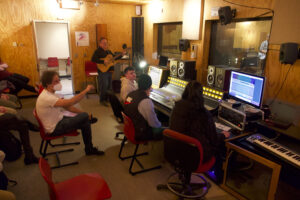SUNY Oneonta music biz track
matches science and art in music

[Editor’s note: We offer this story from a first-person perspective, as your correspondent participated in the classroom and recording sessions about which we write.]
Think of it as STEAM — Science, Technology, Engi-neering, Arts, and Math. All come together in Andris Balins’s Audio Arts Production class at SUNY Oneonta, a hands-on four-semester course taking students through what the class description calls “a more in-depth understanding of acoustics and sound design, as well as a modern theoretical approach to technology in the industry.”
Andris invited The Driftwoods — a band in which I play the drums — to the university’s recording studio in early April to give the class first-hand experience in setting microphones and instrument placement for a live band in a studio setting. It’s a process that doesn’t necessarily happen much these days in a recording industry dominated by laptops and computer-generated loops.
The class had two hours to set up and record our basic tracks and overdubs. Driftwoods leader and Advantage Maytag co-owner John Thompson selected Willie Nelson’s “Angel Flying Too Close To The Ground” for the evening’s track — a song we’d played enough to know we could give the students a basic track in one or two takes. The students collected sound levels for each of the instruments, settled in to a control room dominated by a massive mixing board and multiple computer screens, and off we went.
Two takes later, we were done — the band in the studio and John in the control room for his vocal and lead guitar; John and SUNY Oneonta Music Department chair Rob Roman followed up with overdubs, and the recording was done.
The band joined the students and Andris in the control room to review the take. John asked for a few adjustments that the class fixed quickly with a few computer strokes; I asked if they could edit out a mis-struck cymbal in the middle of the take.
Andris stopped and looked to his students. “Any ideas?” he said.
Class participation fired on every cylinder as the students bounced ideas back and forth. They determined that the microphone from the piano — not just the mikes they had so carefully placed around the drum kit — had picked up the drummer’s error. A simple fix might not be so easily found.
Students jumped at the opportunity the professor afforded, calling out possible high-tech solutions the state-of-the-art computer technology afforded. None of them did the immediate trick until one student recognized the piano chord at the top of the measure matching one played earlier.
“Punch the measure from that piano mike into the one he wants fixed,” he said, and it worked. The fix was in.
“They’re using their ears as much as they’re using the technology,” Andris said two weeks later, when band and students met again to mix the raw recording from the first night. Class began that second evening with a wide ranging discussion among students and teacher covering everything from sine wave identification to Bach’s Well-Tempered Clavier, from physics and math to nanoseconds and the impact of comb-filtering. A deep discussion how far — if at all — to adjust an echo on the lead vocal. A review on the microphone-placement technique, the band’s playing, the balance in the room among live musicians, playing live.
The students — most unfamiliar with the classic country song we performed — tuned in as the playback rolled. Pull back on the bass drum and focus more on the track from the overhead mike. Look for a tonal balance on the snare drum. Bring the bass forward in the mix; experiment with the delay on the vocal to make it resonate. The most subtle of adjustments making monumental difference as the
two-hour session progressed.
Andris said he has taught this fascinating class at SUNY Oneonta for more than 15 years as part of the school’s innovative music industry major. He got his start as an audio and recording expert in a recording studio owned by Oneonta’s Wayne Carrington, moving on from there with studies and teaching at Broome Community College. Today, he has more than a decade under his belt working with artists including Sean Lennon, Lana Del Ray, and Nels Cline.
“Working with live musicians lets the students take themselves out of just running a program through another program,” he said. “They’re thinking about the song and the notes. They’re making the musicians comfortable and bringing out a performance.”
Writing as someone who flinches with every notice that it’s time to update my computer or telephone, I’m endlessly impressed by the students’ ease with the advanced technology at their hands. I’m impressed, too, by the way Andris encouraged his class to take control of our session; it was their job to recommend changes to the mix and work with us.
In the end — an outstanding example of world-class education opportunities happening in Otsego County. I can speak confidently for the band — we’re all proud of the end product. The students made us sound good!
[We’ve posted the final product on our Facebook page: https://www.facebook.com/thedriftwoodscountry].


What a great story! As an amateur musician and recording artist, I appreciate the hard work of these students and commend SUNY Oneonta for offering this innovative course. High five, also, to the Driftwoods, first for volunteering their talents to support the students and second for executing a fine (and beautifully produced) version of a Willie classic. Nice job, all!
What a great story! As an amateur musician and recording artist, I appreciate the hard work of these students and commend SUNY Oneonta for offering this innovative course. High five, also, to the Driftwoods, first for volunteering their talents to support the students and second for executing a fine (and beautifully produced) version of a Willie classic. Nice job, all!